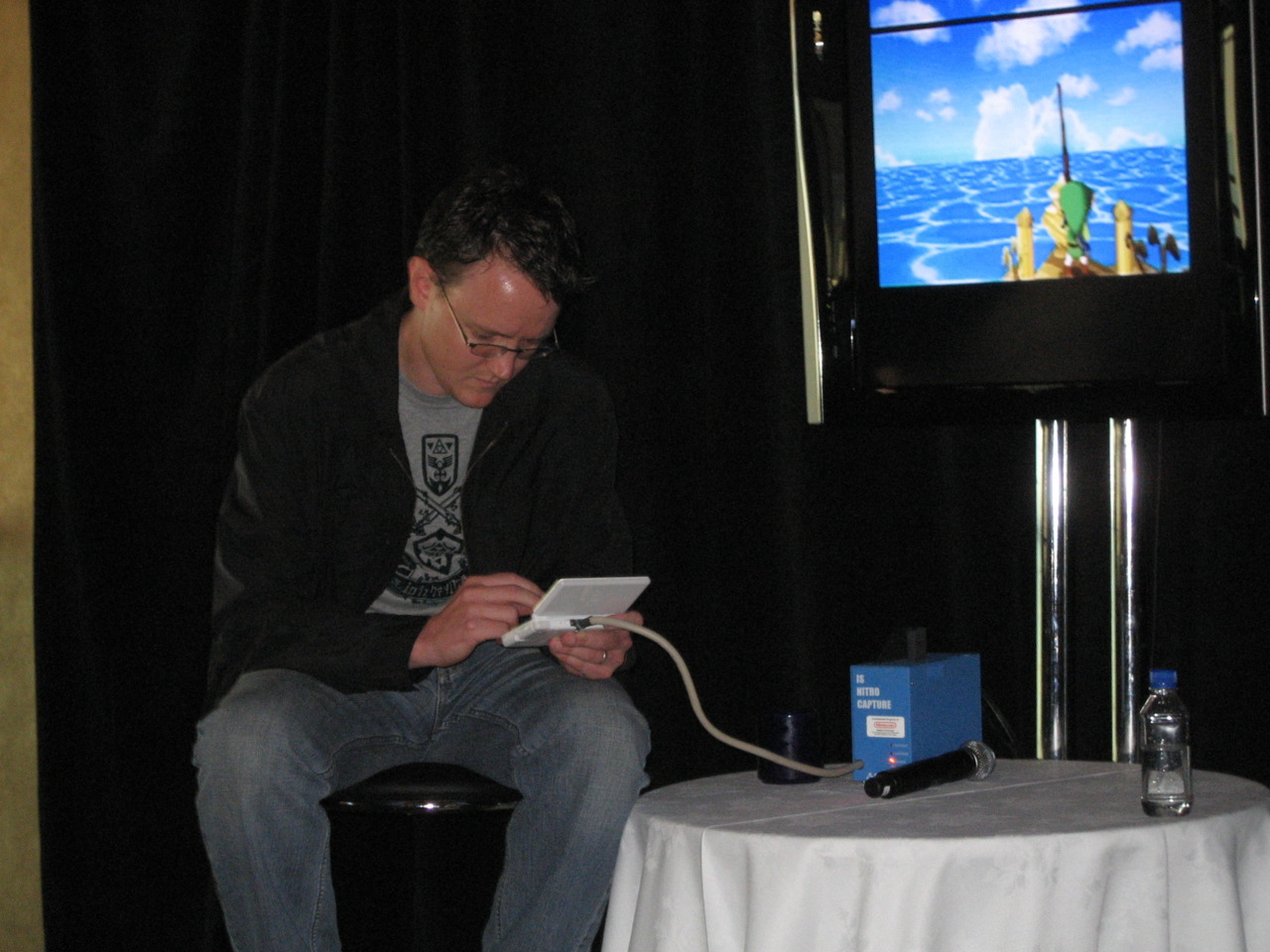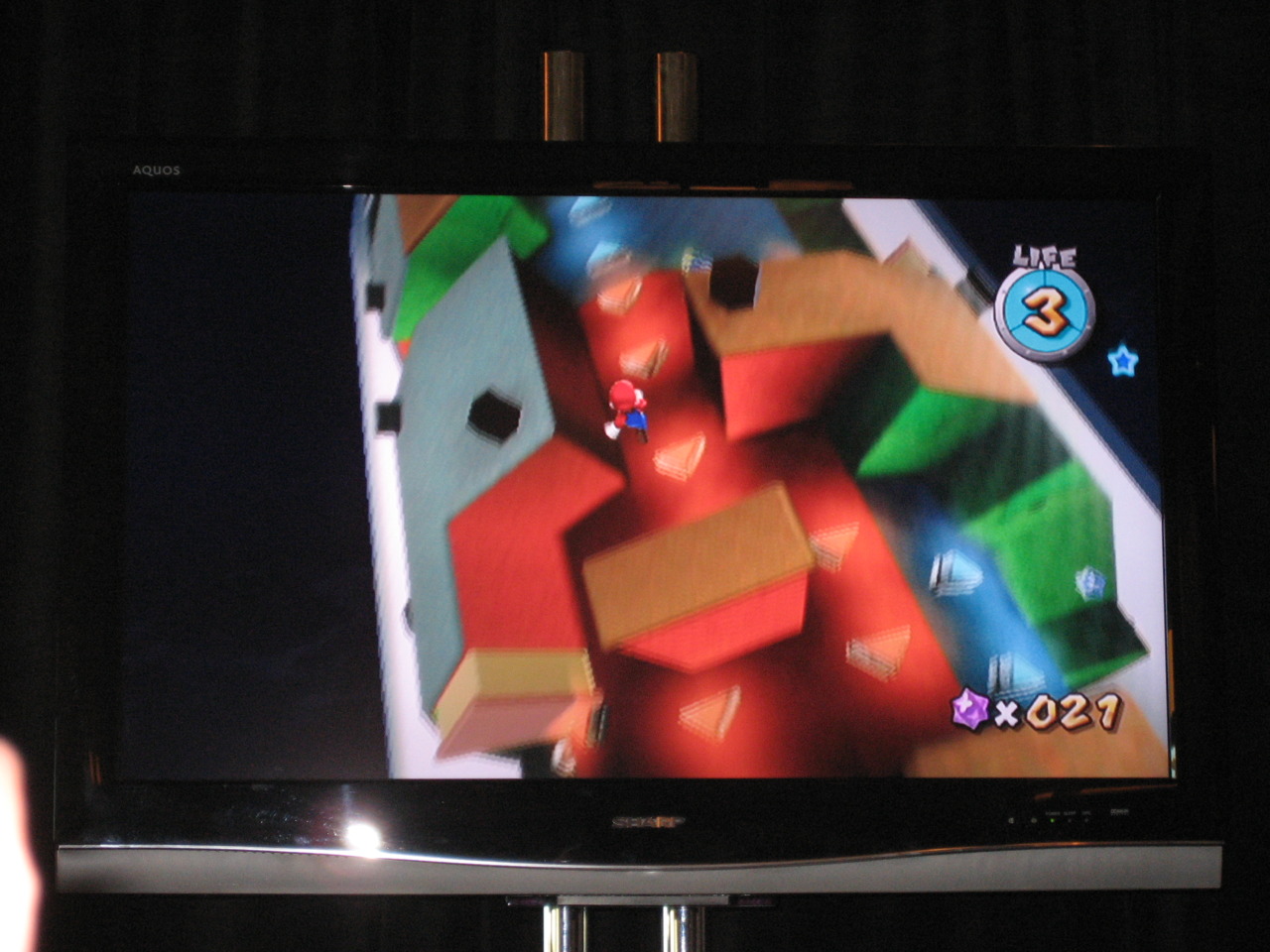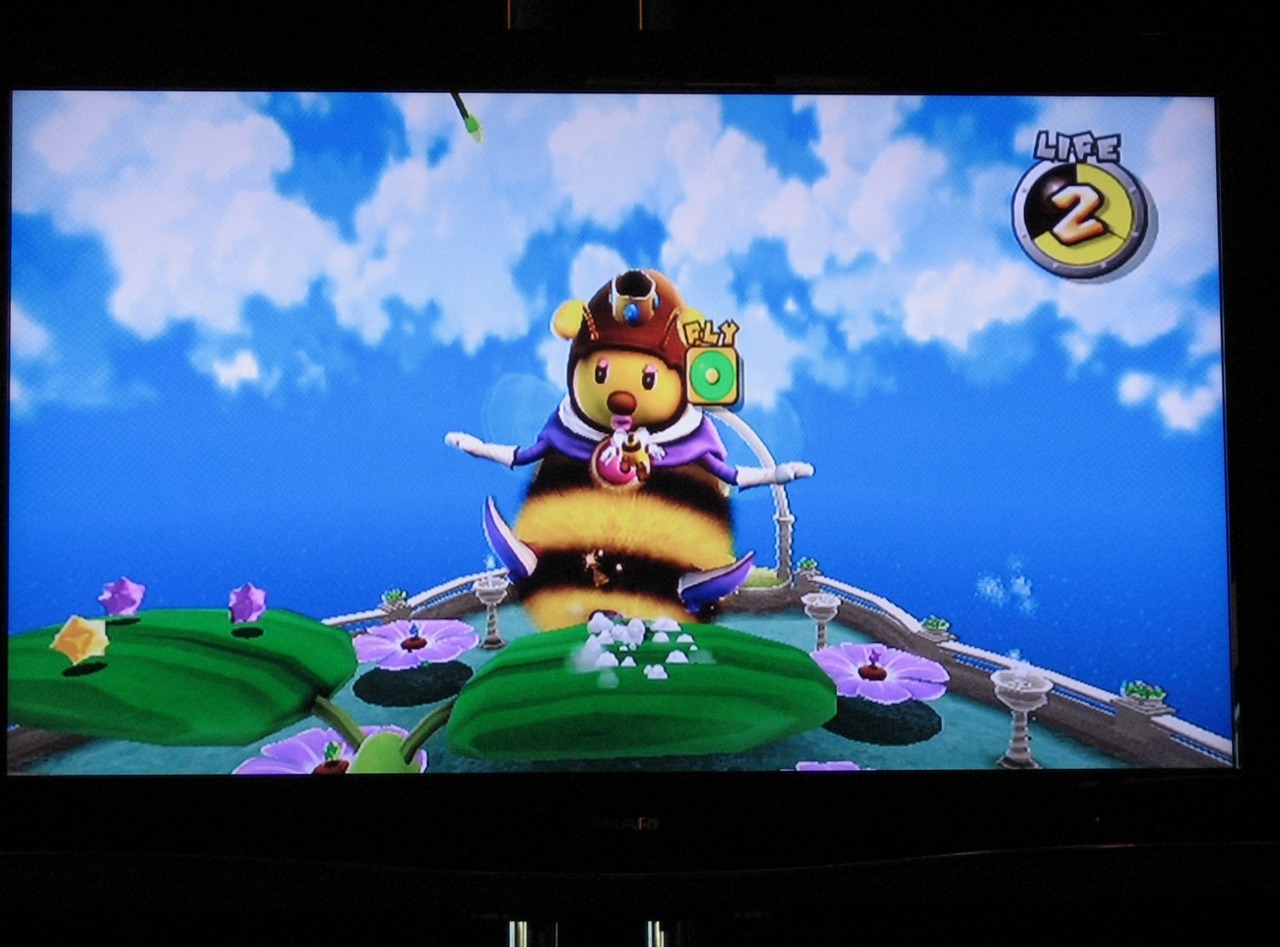E3 '07: Miyamoto shows off Super Mario Galaxy
Legendary game designer holds court with Zelda director Eiji Aonuma at Nintendo round table, shows levels previously unseen by the public.
SANTA MONICA, Calif.--As day two of E3 draws to a close, Nintendo is holding its annual developer roundtable in an intimate meeting room at the Loews Hotel in Santa Monica. A select handful of press members have assembled and are awaiting entry to hear presentations by Nintendo design luminaries Eiji Aonuma, director of Zelda: Twilight Princess, and Shigeru Miyamoto, who...well, who needs no introduction by now.
As attendees enter the room and find their seats, Nintendo public relations manager Eric Walter introduces the program and runs down the agenda. We'll hear from Aonuma first, who will present a game demo and then host a question-and-answer session. We'll hear from Mr. Miyamoto afterward.
[4:11] Mr. Aonuma has taken the stage, along with Nintendo's Bill Trinnen on game-demo duty, to show off Zelda: Phantom Hourglass, the company's latest Zelda release on the DS.
[4:12] He discusses the great success of the game in Japan so far, with 300,000 copies sold in its first week. Stark contrast to Aonuma's talk at the Game Developers Conference in March, where he stated the previous cartoon-like Zelda game, The Wind Waker, met with lower-than-expected sales.
[4:13] Aonuma moves on to talk about the challenges of designing this new Zelda for the DS' unique control capabilities, primarily the touch screen.
[4:14] Of course, the touch screen controls allowed the designers to come up with puzzles that couldn't have worked with regular controls--but surprisingly, Aonuma has found that players without previous Zelda experience have adapted to the new game's challenges more readily than Zelda veterans.
[4:15] He talks about the need to preserve the unique attributes of the Zelda experience--that "aha!" moment you get after a great discovery, for instance--even while adapting the game to its new controls.
[4:17] In addition to the impressive sales after release in Japan, Phantom Hourglass has been especially popular with new demographics, such as adult women.
[4:18] After a brief explanation of the game's hide-and-seek wi-fi multiplayer, Aonuma moves on to discuss the team behind Phantom Hourglass.
[4:18] Aonuma took a producer role on this title rather than director, allowing a new group to implement its own ideas within the Zelda world.
[4:21] In fact, the director of Phantom Hourglass made his directorial debut with this game. Furthermore, much of the game's development team was new to the Zelda franchise before starting on this project.
[4:22] Trinnen is showing the game's sailing sequences, which are similar to those of The Wind Waker. Once again you'll be able to drop anchor and search for sunken treasure, which is on display here. Now you'll have to use the stylus to carefully hoist a treasure chest between floating mines, though.
[4:23] Aonuma emphasizes the satisfaction of successfully finding and rescuing a treasure chest. This is one example of a Wind Waker mechanic that's been refined and polished for Phantom Hourglass. The new fishing minigame is another example.
[4:24] That's all he can say about Phantom Hourglass today. Instead, he moves on to discuss...what's coming in the next Zelda project. Holy cow.
[4:25] Aonuma has a bullet-point list of features in his head already that he wants to implement in the next Zelda. Miyamoto forbade him from letting us in on the secret, though. Rats.
[4:26] But he says he has a child-like excitement about something new like this, and he wants to let us in on the info immediately.
[4:28] Luckily, he doesn't want us to wait for years on end to receive details on the next Zelda, as we've had to do in the past. What a nice guy.
[4:29] The Q&A session with Aonuma begins.
[4:31] When asked about whether we'll see sequels to either Phantom Hourglass or Twilight Princess, he leaves the possibility open to both.
[4:31] Q: If there's another Wii Zelda, will it have one-to-one sword control with the Wii remote? A: We haven't fleshed out all the gameplay ideas yet, but we're certainly open to possibilities.
[4:33] His favorite thing about Phantom Hourglass? Link can be seen scribbling on his map just as you annotate your own. He didn't even know his staff had included such a small detail, until his son gleefully pointed it out.
[4:34] Continues to answer questions about the multiplayer mode, which has Link fleeing from a number of pursuing statues through a maze.
[4:35] Q: After the lessons learned from Phantom Hourglass, will you continue to apply this philosophy of simplification to all future Zeldas?
[4:35] A: Streamlining the gameplay has been effective so far, but they'll wait for feedback from American and European players before making final decisions.
[4:37] Q: Will Aonuma continue to take a hands-off producer's role on future Zeldas from now on? And does he desire to work on other franchises?
[4:39] A: This time, he worked closely with the director, and the process worked out well. He'd be open to a similar arrangement in the future, but each project has its own requirements.
[4:39] Q: Has he considered including variable difficulty levels in a Zelda game?
[4:40] A: He's thought about it, but he wants the core Zelda experience to appeal to the widest range of people it can.
[4:41] Responding to a question, Aonuma has considered what would happen if Link were to visit the contemporary world, or be dropped into a World War II setting. But how such concepts would fit into an actual game isn't easy to say.
[4:42] Aonuma's segment ends as attendees are granted a five-minute break. So hey, give us five, eh?
[4:43] And don't forget--Miyamoto up next!
[4:50] The audience is still milling around, but Mr. Miyamoto has taken his seat (with Trinnen on interpreting duties), and Super Mario Galaxy is now on-screen.
[4:50] Scratch that--we're back to business. Miyamoto comments that it will be hard to focus on business with so many people enjoying themselves on the beach just out the window.
[4:51] He also laments the lack of a physical round table at these "roundtable" events--he needs a table to upend at a dramatic moment.
[4:51] Lately, he's been spending most of his time on Mario Galaxy and Wii Fit, the fitness application announced at Nintendo's press conference yesterday.
[4:52] That conference was geared to a wide audience, which is why the program emphasized Wii Fit. But today, we're looking at the hardcore games, starting with Galaxy.
[4:54] Miyamoto feels that the peripheral pursuits of a game designer are important in informing his or her work on a game. For instance, he's become more health-conscious and has weighed himself regularly on a daily basis, which directly inspired Wii Fit.
[4:55] Wii Fit and Mario Galaxy do have one thing in common--both are being designed to be accessible to anyone.
[4:56] Nintendo is hoping to attract new audiences to Mario Galaxy with a second-player assist mode, which lets another person play alongside the first player (this feature will be demonstrated shortly).
[4:56] Gravity is a big gameplay feature in Galaxy--there will be varying levels of gravity that will factor into the gameplay.
[4:58] One inherent benefit of Galaxy's focus on small planetoid-like levels is that camera control is essentially handled automatically. Since the land masses are so small, the camera's always on the action.
[5:00] They're now going to show off a new level not yet shown here at E3.
[5:01] He shows how, after you've collected enough star pieces, you can feed them to a friendly little star dude. His hunger sated, he zooms off into the sky and creates a new little planetoid.
[5:03] Mario ascends a multi-level planetoid crawling with goombas and covered with spiky plants. He uses a star launch pad to fly over to a capsule-shaped level which he runs around the outside of.
[5:03] Once inside, the capsule becomes a sort of side-scrolling level, as Mario can only run left and right around the perimeter of the capsule.
[5:04] Different areas of ground have different gravitational properties here--some have low gravity, others have inverted gravity that send you right up to the ceiling.
[5:05] The game will have 6 greater areas with 40 galaxies spread across them. Of course, there will be 120 stars to collect, so this should have all the bulk of a typical Mario adventure.
[5:07] Now Mario is floating in a bubble around a star-shaped object, with Miyamoto using the remote as a pointer to click each of the five points of the star. A beam of light shoots out when the point is clicked to help slowly steer Mario. Meanwhile, a menacing-looking black hole floats in the sky.
[5:09] Showing another advanced level, the Star Beam Trail. Now the assist mode is being demoed, as a second player is using her own pointer to help Mario out. The second player will be able to block enemies and such with this pointer.
[5:11] Miyamoto points out that now backseat game players actually have their own pointer to tell their friends where to go or what to do.
[5:11] Of course, assisting players can use their pointer to interfere with Mario a little bit as well.
[5:12] Mario is running along a pathway of blocks floating in space that are constantly and rapidly shifting position and reforming the path in different directions.
[5:13] Next up: the Beach Bowl Galaxy.
[5:14] Not all of the game's levels will be set in space--this one is made out of stones and is set in a blue, slightly cloudy sky.
[5:15] Miyamoto misses a jump and falls off the stones into a very visually appealing vortex of water in the middle, which sends him flying into a black hole and costs him a life.
[5:15] Next, the Cookie Factory Galaxy.
[5:17] This candy-colored level features music from Super Mario Bros. 3 (level 1-3, we think?). It has Mario running along a vibrant conveyor belt marked with numerous holes of many shapes.
[5:18] Even Miyamoto has some trouble--he falls through several holes before inviting a member of the audience to try. But he says even when you die repeatedly, it's still fun in this game to keep trying.
[5:19] The assist mode will let parents help out their small children when playing the game--or maybe the children will need to help their parents instead.
[5:20] Now moving on to the Q&A session.
[5:22] The setup of Galaxy will be similar to Mario 64, in that you'll revisit stages multiple times to claim multiple stars.
[5:23] You knew this was coming--one press member asks about Reggie's comments at the media briefing that Galaxy is the first worthy successor to Mario 64. Does Miyamoto agree? What does this say about Super Mario Sunshine on the GameCube?
[5:24] Miyamoto feels one of Mario 64's best qualities was the simple joy of exploring its 3D environments. The new spherical levels in Mario Galaxy give that same sense of satisfaction.
[5:24] Q: What other applications does Miyamoto see for the Wii Fit controller in the future?
[5:25] A: There's a variety of possibilities. One example is a snowboarding game. In fact, Wii Fit already includes a skiing game, so adapting this would be easy. Third parties will be free to develop their own ideas for the Wii balance board as well.
[5:27] When asked about ideas that didn't make it into Mario Galaxy: The game is still in development, so technically all ideas are still in play.
[5:27] Here's an obvious question after the announcement of Wii Fit: Has the success of the Touch Generations games made Miyamoto less interested in developing traditional or hardcore-style games like Mario Galaxy?
[5:28] "You certainly don't have to worry about that." He's having a lot of fun working on both Galaxy and Wii Fit, and he thinks it's perfectly acceptable to have simpler games that can be completed in a few months while also working on more ambitious projects that take years to complete.
[5:33] When asked about more applications of the Wii balance board, some medical professionals have already expressed an interest in using the device for possible treatment of patients.
[5:36] Miyamoto comments on the recently announced peripherals like the Wii zapper and steering wheel. Since the expensive technology is all contained in the Wii remote and nunchuk, Nintendo is able to release numerous such peripherals at low cost.
[5:42] When asked whether the balance board will be available in different sizes for different markets, Miyamoto says consideration may be ongoing, but whether or not a "super-sized" version will be available in America isn't decided. (Yes, his words.)
[5:42] How long has Mario Galaxy been in development? It's being created by the team that made Donkey Kong Jungle Beat, and development began as soon as that title was finished.
[5:44] Regarding his involvement in Galaxy: He was director on Mario 64, but he's more closely involved with the actual game design for Galaxy. So in a sense, he's more involved in this project than he was in Mario 64. Development is taking place in Tokyo, but the team can send him new builds of the game over a high-speed network so they can video-conference and discuss design every day.
[5:49] Will Mario Galaxy's difficulty be tuned for skilled hardcore players or will it be made easier for a wider audience? Miyamoto has struggled with that question of balance for a long time. For Galaxy, he wants a sufficient level of challenge that the player will feel satisfied with completing the later objectives. He's been increasing the game's challenge level over the last few months, to the point that the team has almost expressed concern it will be too hard. But of course the final balance will be as close to ideal as possible.
[5:51] With that question, Walter retakes the stage to thank the attendees for sharing in the excitement of Nintendo's very busy last year. We're off to hit the boardwalk and continue our E3 coverage through the last day of the show.
Got a news tip or want to contact us directly? Email news@gamespot.com




Join the conversation